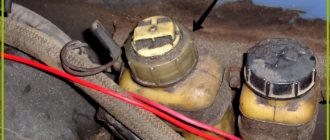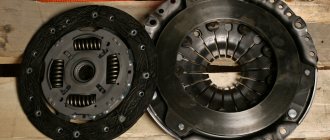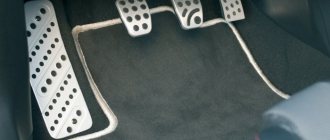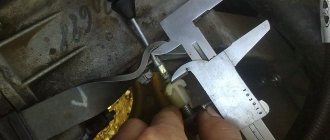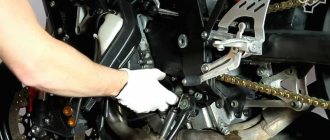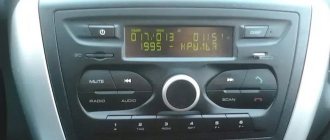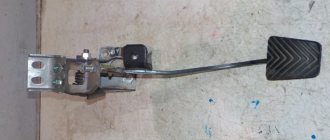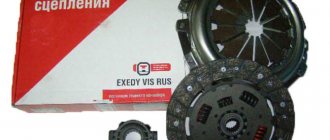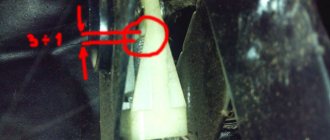September 20, 2019 Lada.Online 10 745 0
To identify the noise of the clutch release clutch on LADA Vesta, Granta, Kalina, Priora, XRAY AMT, Lada 4×4 cars, a special technique was compiled at AVTOVAZ. Specialists of LADA dealership centers refer to this instruction. The methodology was sent to the Lada.Online website by one of the site’s readers.
When assessing the malfunction of the clutch release bearing, it is necessary to take into account that at the moment all cars produced by JSC AVTOVAZ use a clutch without clearance, so the clutch release bearing is always preloaded and rotates with the engine running.
Prerequisites - clutch noise
As a rule, the whistle occurs suddenly, but for an attentive driver such a phenomenon will not go unnoticed. Always, before the clutch squeal appears, it will begin to vibrate and make a little noise. This noise can be regarded as follows: press the pedal - the noise appears, release it - the noise disappears.
If you drive for a long time with such noise, you will eventually hear a squeal or a very loud whistle when you press the clutch pedal. A trip with such a problem will not be long, so you need to take action.
How to extend the resource?
To increase the service life of the device, you must drive on smooth roads. In our country, it is problematic to comply with this condition. Keep in mind that uneven roads destroy not only the vehicle’s chassis, but also the clutch system. Therefore, regular off-road driving is also dangerous for bearings. Don't make mistakes when operating your car. When the car is stopped at a traffic light, there is no need to depress the clutch pedal and engage first gear if you do not plan to move. This should only be done at the beginning of movement, since the part operates under high load conditions. Regular lubrication will increase the service life of the device.
Loading …
Causes of Squealing, Whistling, or Clutch Noise
The most common reason is the release bearing. If you hear a squeal or whistle when you press the clutch pedal, then with a 90% probability it is the one that has failed. As a rule, the car still starts to stall. But in some cases the motor continues to operate. The fact is that after working for a long time without proper lubrication, the release valve began to jam. This manifested itself in vibrations or noises, and then it just jammed and this whistle appeared.
But there is another reason - these are the crankshaft half rings. They prevent axial movement of the crankshaft when the clutch is pressed. If one of them falls into the pan, then the appearance of such a whistle cannot be avoided. You can find out about the movement of the crankshaft and the condition of the half rings with the following test:
- The partner gets behind the wheel and squeezes the clutch.
- You are looking at the crankshaft pulley.
- If there is noticeable play of more than 2 millimeters, then the half rings must be replaced
If the half rings fall out, they need to be replaced as soon as possible, otherwise, in addition to the half rings, you will also have to change the cylinder block with the piston.
Why is the box noisy?
Gearbox noise is one of the unpleasant moments in operation, which is associated with design features. Owners note noise in the Kalina Cross, Sport, hatchback, and station wagon gearboxes when using box 2181. However, Kalina noise can also appear on an automatic transmission.
Oil too thick
If the gearbox on a Lada Kalina makes noise immediately after starting the engine, but the noise decreases while driving, the reason may be that the oil is too thick. However, fluids such as 85w90, for example, may be better than 75w80 precisely because of their increased viscosity, since they better fill the gaps between parts.
The thickness of the oil affects the occurrence of noise in the box.
Meanwhile, too thick oil makes it difficult for the gearbox to operate, especially when starting the engine.
Low oil level
One of the reasons for noise in the Kalina Cross, Sport, hatchback, and station wagon gearboxes, both with manual and automatic transmissions, is a low oil level. At the same time, “kicks” occur in the automatic transmission when changing gears.
To fix this, you can try adding oil to the box. However, it is difficult to check its level, since some models do not have a dipstick (on 2181). By unscrewing the oil filler plug, you can roughly determine the sufficiency of oil in the transmission - if it leaks, then there is enough oil, if not, then it is better to top it up.
In other models (2180, “Robot”, automatic transmission), the oil level can be checked with a dipstick and topped up to the required level, while only on the first two the procedure is carried out “cold”.
Worn bearings
On Kalina 1st and 2nd generations, noise in the gearbox may be from worn bearings of the primary and secondary shafts. When parts are replaced, the noise may decrease.
Checking the box bearings
It is possible to determine that the cause of the noise is a bearing without diagnostics, especially when it comes to the input shaft bearing. If the universal gearbox on a Kalina (2180) or another manual transmission makes noise when the selector is in neutral, then most likely it is the input shaft bearing.
But in neutral, the release bearing can also make noise. If this is the case, then when you press the clutch pedal (on a manual transmission), knocking, rattling, or other similar sounds begin to appear. If the input shaft bearing is faulty, if you depress the clutch pedal, the gearbox noise disappears, but when driving at speed (1st and 2nd gear), that is, at increased speeds, on the contrary, the noise turns into a howl.
The same applies to automatic transmission.
Hull damaged
The hum in the box appears due to damage to the housing. If the box on the 1st and 2nd generation Kalina is noisy when gears are freely changed (but with the possibility of some gears falling out) and there is virtually no oil in the box, then the likelihood of damage to the body increases. And if you drive with a “dry” gearbox, the risk of damage to the unit and the appearance of chatter (from faulty bearings) increases.
Dirt got into the oil
Automatic transmission noise on Kalina can also appear when dirt gets into the gearbox oil. When the gears are engaged, the clutches slip. This in most cases means a clogged filter mesh or insufficient oil level.
If water gets into the oil, then the automatic transmission noise is associated with slipping. This occurs due to foaming of oil and water, and the resulting emulsion clogs the filter. This can be corrected by eliminating the leak (identifying where the water is leaking from), washing the disassembled gearbox and using new oil.
Whistle when pressing the clutch pedal of the Priora
- To the beginning of the forum
- Forum Rules
- Old design
- FAQ
- Search
- Users
2100 km round trip). I walked along the highway at 90-120 km/h. At the end of the way back, already at the entrance to the city, I noticed a strange sound when releasing the clutch pedal - either a creaking or a low whistle. I thought about the cable. Yesterday I sprayed it with VDshka, sprayed the cable attachment point and the pedal assembly. The sound does not appear when the car is not running. Appears only when the engine is running. From which I concluded that it was the release lever whistling. Valeo clutch, the assembly was replaced about 15 thousand years ago. Who had this? How to treat? Or give up and move on? Won't the bearing fall apart?
Let's figure it out again. The bearing should be changed when it makes a sound when PRESSED.
Hm. and if the sound appears when released. those. Does the sound go away when you press the other way around? then what do we do?
)
-=Worm=-
mine, a bad person, whistles when the pedal is released.
to hell with it? I just don’t understand why this crap started. I didn’t seem to burn the clutch, I was driving at cruising speed, can I just try adjusting the cable?
-=Worm=-
mine, a bad person, whistles when the pedal is released.
to hell with it? I just don’t understand why this crap started. I didn’t seem to burn the clutch, I was driving at cruising speed, can I just try adjusting the cable?
they will convince you that this is the input shaft bearing
What else is spinning at idle? Maybe, of course, the input shaft gears themselves make such a sound, but they are not engaged.
I think the sound is similar to what people describe here, I would even call it a growl. This sound is already about 30 thousand km. started showing up a while ago. I used to notice that it appeared sometimes, mainly after a long drive; smoothly pressing and releasing the clutch helped. Now he growls almost constantly.
Not necessarily the same, they just changed my friend’s yesterday. You just need to do it right away so as not to drag the box back and forth every 15 thousand. And if such a reaction occurs, then I advise you to contact a service center where they will convince you that it is the input shaft bearing.
1.What kind of release gear did you give my friend? Is this together with the Valeo disc basket? Or does he have a different clutch? 2. By the way, yesterday there was a “garage consultation”
I decided that it was the primary shaft bearing that was whistling. 3. How to do it “properly”? 4. About 4 thousand years ago I changed the main shaft oil seal, installed a tenth one, it is 1 mm thicker, but I foolishly did not push it deep. Maybe this is due to a defective oil seal.
Whistle when pressing the clutch pedal of the Priora
- To the beginning of the forum
- Forum Rules
- Old design
- FAQ
- Search
- Users
but it seems like the clutch should drive
Saprankov, urgently check the axial play, most likely it’s still half rings. A couple of years ago, a half ring ground down to zero and ground the crankshaft seat cover. True, this whistling-creaking progressed very quickly for me, literally in one trip, I drove into the garage with a wild creak. By the way, when you press the clutch, do your revs drop, if so, then most likely it’s a half ring.
Added after 2 minutes 24 seconds:
By the way, the noise was coming from the clutch basket itself, which, due to the large play, moved forward (when pressed) and touched the casing.
The input shaft bearing makes noise when the pedal is not pressed.
Why are you scared? When the clutch is engaged (the pedal is not pressed), the front bearing of the gearbox input shaft does not work - the input shaft rotates synchronously with the crankshaft.
As it got colder, the whistle disappeared completely, so for now I drive as before. I didn’t touch the half rings, because I checked with a friend - there was no play in the pulley. The revolutions when the clutch is pressed are rather the opposite - they increase slightly (by 20-40 approximately according to BC)
Added after 2 minutes 44 seconds:
By the way, the new generator from Startvolt has been whistling since new for a year and a half - there is no play either and it works as it should.
Source
Defects that appeared after replacing the clutch
What does it mean to replace the clutch? This action means changing the driven or driven clutch disc; often both parts are changed at once. In this case, the release bearing must also be replaced. After such an operation, side defects are suddenly revealed that were not there before the repair.
If we think logically, then there are few reasons for the appearance of new malfunctions. Typically this is:
- Unqualified repairs;
- Defect of new spare parts;
- Erroneous diagnostics, as a result of which not all or the wrong parts were replaced, and previously hidden problems manifested themselves in full.
In general, the issue of the appearance of new unpleasant signs is very difficult and is individual in each specific case, but these signs have common characteristic features.
If after replacing the clutch the car jerks
For example, before the repair, the car did not pick up speed well, it was slipping, and the clutch pedal was activated at the very top. All the signs of a worn driven disc were present. After replacing the disk, the car began to jerk. What could happen after the repairs were carried out?
- The issue may be a defective part. This is not so rare when it comes to non-original spare parts. In Russian-made cars (VAZ, GAZ, AZLK, IZH), defects also occur in factory parts. That is, the driven disk is simply curved. On the clutch basket (drive disc), the pressure petals may be at different levels, then the release occurs unevenly and the car jerks.
- The car may jerk due to clutch adjustment. More precisely, it was not performed after replacing the disk. The linings of the new part are much thicker; in this case, the clutch pedal “takes at the very end”. When starting off, the car moves jerkily, and the gear shifts into gear with a crunch.
- The car jerks due to the replacement of not all the parts that needed it. In particular, the cause of jerking is the worn surface of the flywheel under the driven disk. If the flywheel has not been replaced, there may be jerking when driving, and the car may also slip.
Adjusting the clutch system and release bearing
If the clutch mechanism is not working properly, the car moves jerkily, jumpily, the lever sinks, and various sounds are emitted from the box.
Good performance properties of a car depend on the quality of operation of three motion systems: gas, brake and clutch mechanisms. To adjust the clutch, sometimes it is enough to adjust the drive; in other cases, repair and replacement will be required. Adjustments must be made on time to avoid breakdowns that require large financial costs. The main signs of a malfunctioning clutch mechanism: the car moves jerkily, jumpily, the lever sinks, various sounds the gearbox Ideally, after depressing the pedal, the car should move slowly and smoothly. Sometimes a lot depends on the little things, and it would seem that such a small part of a large machine, like a release bearing, is a drop in the bucket. But in practice, everything is not so; even the smallest particle that has become unusable requires attention. An experienced driver will be able to repair or replace the release bearing; a beginner will most likely go to the nearest service station or try to solve the problem on his own by reading this article. Good luck on the roads!
If there is a noise or whistle after replacing the clutch
Many car owners often complain that after replacement, a noise or whistle appears that was not there before. What could be the reasons for the extraneous sound and why does this happen? » alt=»»>
- The new release bearing turned out to be of poor quality or does not contain enough factory lubricant. A whistling or noise appears when you press the clutch pedal. Many people mistakenly believe that the bearing makes noise when the clutch is disengaged. But this is even illogical, in this state the part does not bear the load, and accordingly the noise (whistle) in this state is minimal.
- The clutch basket has unevenness and roughness at the tips of the pressure petals. Typically, spare parts from Russian manufacturers have such a defect. It should be noted that as the parts are ground in, the whistle that appeared initially disappears. You can temporarily eliminate the noise by lubricating the petals with lithol. But this can be done without disassembly on GAZ cars; on front-wheel drive cars, to perform a similar procedure it is necessary to dismantle the gearbox.
- It is possible that before replacing parts, the car owner did not pay attention to extraneous noises such as whistling, as he was expecting repairs. But after replacing the clutch, extraneous sounds remained, which the owner of the car did not expect. Noises are often caused by the gearbox. If, when the clutch is depressed, the unpleasant sound disappears or noticeably subsides, then most likely this indicates wear on the gearbox input shaft bearing.
- The driven disc linings have roughness. A rustling noise occurs when changing gears. There is no need to worry too much ahead of time - the new parts will get used to it, and the defect will disappear during the operation of the car quite quickly.
- The input shaft bearing in the crankshaft may also make noise. When disassembling the car, you should do an external inspection of the bearing. If it is very dry, it must be lubricated with lithol or other suitable lubricant. It is better to replace a clearly worn part immediately.
How to remove and replace a release bearing
Removing the release bearing
An important rule for the release bearing: it should not “play” or move unevenly or spasmodically.
If repairs are necessary, you will have to disassemble the entire gearbox, because... the required part is inside it. Next, the spring clamp is released from tension, and the bearing itself is removed. To do this, you will need a tool, because you will have to remove it from the spring “legs” of the holder. Remove from the bushing, removing the retaining springs, and disconnect from the coupling. The removed part is inspected for cracks and other external signs of failure. It is more reliable to install a new spare part, since it is relatively inexpensive. After all actions, lubricate. How to lubricate the release bearing? Some people prefer molybdenum grease, others prefer graphite; parts are usually supplied with it when purchased in a store. An important rule for a bearing: it should not “play” or move unevenly or spasmodically. How to lubricate the release bearing without removing the box? You will have to contrive, it is almost impossible to provide good thorough lubrication without removing the gearbox. In any case, if the bearing hums, it is best to replace this part with a new one! Beginning motorists may have difficulties with how to change the clutch release bearing; this is quite a troublesome undertaking if there are no basic repair skills. That's why some people turn to a car service center for help. How much does it cost to replace a throwout bearing? This procedure will cost approximately from 2000 to 5000 thousand rubles.
If there is a knocking noise after replacing the clutch
As a rule, the cause of knocking after replacing parts is defective parts. In particular, there are dangling damper springs in the driven disk. Therefore, before installing such a spare part on a car, you need to carefully inspect it. Parts of the disk may also be poorly riveted. » alt=»»> Knocks in the clutch area can occur due to a crack in the release bearing bushing (the bushings are often made of plastic). Even at the site where the bushing fits on the flange of the gearbox input shaft, play may form, which also leads to a knocking sound.
The knocking noise occurs due to a broken clutch basket petal, but such a defect occurs infrequently. Another reason for the knocking is a broken starter housing in the Bendix area; it rattles when the car moves. A tooth on the flywheel crown may break off, and it will also knock when touching the rotating parts.
Removing and installing the Lada Priora clutch
Replacing the clutch.
Instructions for clutch repair, troubleshooting Lada Priora 2170, procedure for removing and installing the disc on Lada Priora cars. Maintenance and repair of transmission Lada 2170, 2172 Priora. Wheel drive. Replacing the VAZ 2171 clutch. You will need: an “8” wrench (a socket head is more convenient), a large screwdriver...
...a mandrel for centering the driven disk (can be made from the input shaft of the gearbox by removing the gears).
1. Remove the VAZ 2170 gearbox (see “Removing and installing the gearbox”).
2. If you are installing the previous VAZ 2171 pressure plate, mark in any way the relative position of the disc housing and the flywheel in order to install the pressure plate in the same position as before removal (to maintain balancing).
3. Install the mandrel into the pressure plate hole.
You can dismantle the clutch without a mandrel, but at the same time hold the driven disk: it may fall out of the clutch housing.
4. While holding the flywheel from turning with a screwdriver, remove the six bolts securing the clutch pressure plate housing to the flywheel. Loosen the tightening of the bolts evenly: each turn of the wrench, moving from bolt to bolt along the diameter.
5. Remove the clutch housing assembly with the pressure plate.
6. Pull out the driven disk along with the mandrel.
7. Cracks on the driven disk parts are not allowed. Check the wear of the friction linings 1. If the heads of the rivets 2 are recessed to a distance of less than 0.2 mm, the surface of the friction linings is oily or the rivet joints are loose, then the driven disk of the Priora fret must be replaced. Check the reliability of the damper springs 3 in the sockets of the driven disk hub; if the springs are broken, the disk must be replaced.
8. Check the runout of the driven disk if warping is detected during a visual inspection. If the runout exceeds 0.5 mm, replace the VAZ 2172 disk.
9
Inspect the working friction surfaces of the flywheel and pressure plate of the Lada Priora, paying attention to the absence of deep marks, scuffs, nicks, obvious signs of wear and overheating. Replace defective components
10. Using an external inspection, evaluate the condition of the disc spring 1 of the pressure plate. Cracks on the spring are not allowed. The contact points of the spring petals with the clutch release bearing must be in the same plane and have no obvious signs of wear (wear should not exceed 0.8 mm). Otherwise, replace the pressure plate assembly. If the rivet connections of 2 parts of the casing and the pressure plate of the Priora fret are loosened, replace the pressure plate assembly.
11. Assess the condition of the priora compression spring support rings. The rings should not have cracks or signs of wear. Otherwise, replace the pressure plate assembly.
12. Before installing the clutch, check the ease of movement of the driven disk along the splines of the input shaft of the Priora gearbox. If necessary, eliminate the causes of jamming or replace defective parts.
13
Please note that when installing the driven disk into the pressure disk housing of the VAZ 2170, the more protruding part of the hub should be directed towards the pressure spring
14. When installing the clutch, first install the priora driven disc using a mandrel...
15. ...then place the pressure plate casing on the three centering pins and screw in the bolts securing the casing to the flywheel.
- 16. While holding the flywheel from turning with a screwdriver, evenly tighten the clutch-to-flywheel bolts: each one turn of the wrench, moving from bolt to bolt along the diameter. The tightening torque of the bolts is indicated in Appendix 1.
- 17. Remove the mandrel and install the gearbox
- 18. Install the lower end of the clutch release cable on the Priora gearbox and restore the original adjustment of the clutch release cable (see “Replacing the clutch release cable on a Lada Priora”).
Before restoring the original cable adjustment, it is necessary to restore the wear compensation mechanism for the linings of the VAZ 2171 2172 clutch disc to its original state, since if the clutch disc is completely worn out, the wear compensator slider will remain in the lowest position. After installing a new, unworn driven disk, the length of the threaded part of the lower end of the cable may not be enough to restore the initial position of the cable.
To bring the wear compensation mechanism to its original position, by installing size L (see “Replacing the VAZ 2170 clutch release cable”) between the driver and the clutch release fork lever, move the clutch pedal up until it stops - the spring of the mechanism will automatically return the slider to its original position. Then check the L size again and adjust if necessary.
vazclub.com
Clutch slipping after replacing all its parts
After replacing all elements, adjustment is required, but many car owners ignore this point. The cause is slipping, the car accelerates slowly, the engine speed does not correspond to the speed of the car. The engine just roars, and the car is driving quite slowly, as they say, slipping.
In cars with a mechanical clutch cable, adjustment is made by the cable itself. In hydraulically driven machines, this process is carried out using a clutch rod. In modern cars, you often come across rods that do not have adjustments. But this does not mean at all that it cannot be produced. In such cases, adjustment of the clutch pedal itself is provided, but not everyone knows about this possibility. » alt=»»>
Vibration that occurs after replacing clutch elements
There are few reasons why vibration occurs after replacing a clutch. Vibration usually appears in two forms:
- The pressure plate (clutch basket) is not balanced;
- During assembly, the driveshaft was installed in a different position from the original installation (but this only applies to rear-wheel drive or all-wheel drive vehicles).
By and large, on cars with front-wheel drive, you can inaccurately secure the wheel drive (CV joint), and the movement of the car will be accompanied by vibration and knocking, but this does not happen often.
If the clutch basket creates vibration, you can try moving it to a different position. As a rule, the pressure plate mounts are symmetrical. On many models, the basket is attached to the flywheel with six bolts, and the basket can be placed in three positions. In one position the vibration may disappear completely or be minimal. But it is better to exchange the warranty part immediately for another one. This will be less hassle for the car owner.
Which bearing is better
Many car owners try to replace it with a “original” part from the car manufacturer. But, for example, domestic spare parts from Lada cannot be characterized as the most durable and durable. Popular models are from the German company Sachs or the official supplier for our AvtoVAZ - the Italian bearing Coram. The price leader is Sachs; this is an inexpensive and acceptable quality alternative to replacing a faulty part. You can also choose EXEDY and SASSONE from more inexpensive models.

